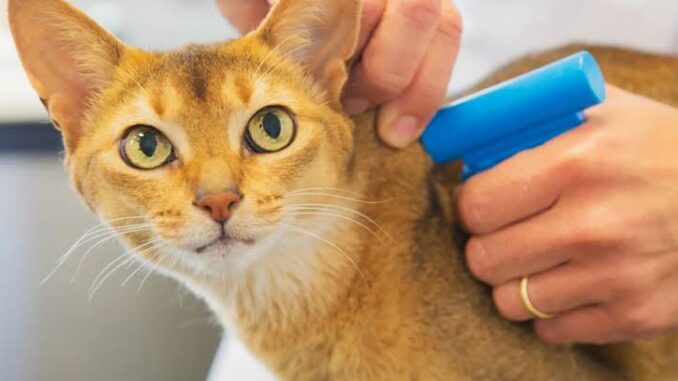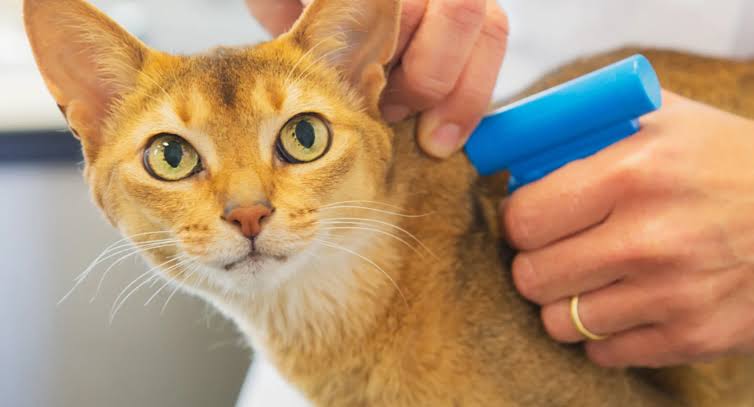
The Benefits of Microchipping Your Cat: Cats are famously independent creatures. Whether lounging indoors or sneaking out for an unsanctioned backyard adventure, they’re masters of slipping out of collars or going unnoticed until they’re long gone. In such scenarios, microchipping can mean the difference between permanent loss and a joyful reunion.

Microchipping a cat is a simple yet profoundly important measure in responsible pet ownership. In a world where millions of pets go missing annually, a microchip serves as a permanent, reliable form of identification that stays with your cat for life. This article delves into what microchipping is, how it works, and why every cat owner should consider it.
What Is Microchipping?
A microchip is a tiny electronic device about the size of a grain of rice implanted just under a cat’s skin, typically between the shoulder blades. It contains a unique identification number that can be read by a handheld scanner.
This number is registered with a national database, along with the owner’s contact information. If your cat is found and scanned, the microchip leads to you.
How the Microchipping Process Works
1. Insertion
The chip is inserted using a needle, similar to how vaccines are administered. The procedure is quick, relatively painless, and doesn’t require anesthesia.
2. Registration
Once implanted, the microchip must be registered with your contact details in a pet recovery database. This is a crucial step—an unregistered chip is essentially useless.
3. Scanning
Veterinarians, shelters, and animal control centers are equipped with universal scanners. When a lost pet is brought in, a quick scan reveals the chip’s ID number, enabling staff to look up the owner’s contact information.
Top Benefits of Microchipping Your Cat
1. Permanent Identification
Unlike collars or tags, which can fall off or be removed, a microchip is permanently embedded under the skin. It cannot be altered, faked, or lost.
For indoor cats who rarely wear collars, this becomes their primary form of identification.
2. Increases Chances of Being Reunited
According to the American Veterinary Medical Association (AVMA), cats with microchips are more than 20 times more likely to be returned to their owners if lost.
Even indoor-only cats are at risk of getting out through open windows, doors, or during emergencies like fires or natural disasters. A microchip greatly increases the odds of their safe return.
3. Quick and Safe Procedure
Microchipping is minimally invasive and usually doesn’t require sedation. Most cats tolerate it well, especially when done during another routine procedure like spaying or a vaccination.
4. Universal System
Most microchips are compatible with universal scanners, meaning that no matter where your cat is found (in the country or internationally), shelters can read the chip and contact you.
5. Proof of Ownership
In cases of pet disputes or theft, a microchip provides legal proof of ownership. If someone claims your cat is theirs, the chip helps resolve the matter swiftly.
6. Peace of Mind
Knowing your cat is microchipped offers reassurance. Even if they escape without a collar or tag, you know there’s still a solid link between them and you.
7. Essential for Travel
Many countries require pets to be microchipped for international travel. It’s a prerequisite for health certifications, passports, and import permits.
8. Lasts a Lifetime
A single microchip implant typically lasts 15–25 years, covering your cat’s entire lifespan without needing replacement.
Addressing Common Misconceptions
“My cat never goes outside, so it’s not necessary.”
Many lost pets were indoor-only before their escape. Open doors, windows, and natural disasters happen—and when they do, a microchip is your best defense.
“My cat has a collar with tags.”
Collars can break, fall off, or be removed. Tags wear out and become unreadable. Microchips are internal and can’t be lost.
“Microchipping is expensive and painful.”
It’s neither. The cost ranges from $25–$60, often including lifetime registration. The insertion is quick and less painful than a vaccination in many cases.
“It’s like a GPS tracker.”
Microchips are not GPS devices. They don’t actively track your cat’s location. They provide a way to identify and contact the owner once the cat is found and scanned.
How to Register and Keep Information Updated
Registering your cat’s microchip is absolutely essential. Without this step, the chip provides no way to reach you.
Steps:
- Ask your vet for the chip’s ID number and manufacturer.
- Visit the registry website (e.g., HomeAgain, PetLink, AVID).
- Enter your contact details, address, and emergency contacts.
- Keep the information current—especially if you move or change phone numbers.
Many registries offer lifetime registration or annual update reminders.
READ ALSO: 5 Reasons Your Cat Might Be Overgrooming
What to Do If You Adopt a Cat with a Microchip
- Ask your shelter or vet to scan the cat and identify the chip.
- If the chip is already registered, you may need to contact the registry to update the ownership.
- Some organizations require proof of adoption to transfer ownership.
FAQs
At what age can my cat be microchipped?
Most kittens can be microchipped as early as 8 weeks old, though many vets wait until 12–16 weeks or during spay/neuter procedures.
Is microchipping painful for my cat?
The process is quick and similar to a vaccination shot. Most cats experience only mild discomfort or none at all.
Can the microchip move or cause health problems?
Chips may migrate slightly under the skin but remain scannable. Modern chips are biocompatible and safe. Adverse reactions are extremely rare.
Do microchips need maintenance?
No. Microchips are passive and don’t require power or maintenance. Just keep your registration up to date.
How do I know if my cat’s chip works?
Ask your vet to scan your cat during annual checkups to confirm it’s functioning and properly placed.
Can someone remove or disable the chip?
Removing a microchip requires surgery and is rare. The chip doesn’t broadcast any signal, so there’s little incentive to remove it.
What happens if I lose my cat and someone finds them?
Most shelters and vets automatically scan found animals. If your chip is registered, they’ll call you using the listed contact information.
Can microchips store my cat’s medical records?
Some systems allow limited medical data, but primarily the chip stores only an ID number linked to your contact info in the database.
Can microchips track my cat in real time?
No. Microchips are not GPS devices and cannot track location. For real-time tracking, you’d need a separate GPS collar.
What if I move or change my phone number?
You must update the information with the microchip registry. Many allow online updates or have mobile apps for convenience.
Leave a Reply
You must be logged in to post a comment.